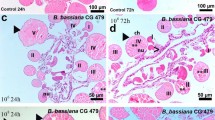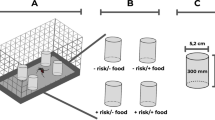Abstract
Batches of engorged Rhipicephalus appendiculatus ticks (females, nymphs and larvae) were placed in gauze-covered vials in the field at monthly intervals and left to complete development. The ticks were placed in open areas and tree shaded areas; the latter being consistently cooler.
The duration of development varied seasonally and was inversely related to environmental temperature. The mean time to oviposition ranged from 5 days during the hot dry season to 25 days during the cool dry season. There was a high larval mortality during the larval to nymphal moult. However, the available data shows that the mean time to larval-nymphal moult ranged from less than 2 weeks during the hot dry season to 7 weeks in the cool season. The mean time to nymphal-adult moult ranged from less than 3 weeks in the hot season to over 13 weeks in the cool dry season. Egg hatching ranged between 3 weeks in the hot dry season and 15 weeks in the cool dry season.
Similar content being viewed by others
References
Arthur D. R. (1951) The bionomics of Ixodes hexagonus Leach, in Britain. Parasitology 41, 82–90.
Branagan D. (1973) The development periods of the ixodid tick Rhipicephalus appendiculatus Neum., under laboratory conditions. Bull. ent. Res. 63, 155–168.
McCulloch B., Kalaye W. J., Tungaraza R., Suda B’Q.J. and Mbasha E. M. S. (1968) A study of the life history of the tick Rhipicephalus appendiculatus—the main vector of East Coast fever—with reference to its behaviour under field conditions and with regard to its control in Sukumaland, Tanzania. Bull epizoot. Dis. Afr. 16, 477–500.
Newson R. M. (1976) The life cycle of Rhipicephalus appendiculatus on the Kenyan Coast. Proceedings of the International Conference on Tick-borne Diseases and their Vectors. Edinburgh, Sept.—Oct. 1976. pp. 46–50.
Semtner P. J., Sauer J. R. and Hair J. A. (1973) The ecology and behaviour of the lone-star tick (Acarina: Ixodidae). III. The effect of season on moulting time and post-moult behaviour of engorged nymphs and adults. J. med. Ent. 10, 202–205.
Wilson S. G. (1946) Seasonal occurrence of Ixodidae on cattle in Northern Province, Nyasaland. Parasitology 37, 118–125.
Yeoman H. G. (1966) Field vector studies of epizootic East Coast fever. II. Seasonal studies of Rhipicephalus appendiculatus on bovine and non-bovine hosts in East Coast fever enzootic, epizootic and free zones. Bull. epizoot. Dis. Afr. 14, 113–140.
Author information
Authors and Affiliations
Rights and permissions
About this article
Cite this article
Punyua, D.K. Development Periods of Rhipicephalus Appendiculatus Neumann (Acarina: Ixodidae) under Field Conditions. Int J Trop Insect Sci 5, 247–250 (1984). https://doi.org/10.1017/S1742758400001508
Received:
Revised:
Published:
Issue Date:
DOI: https://doi.org/10.1017/S1742758400001508




